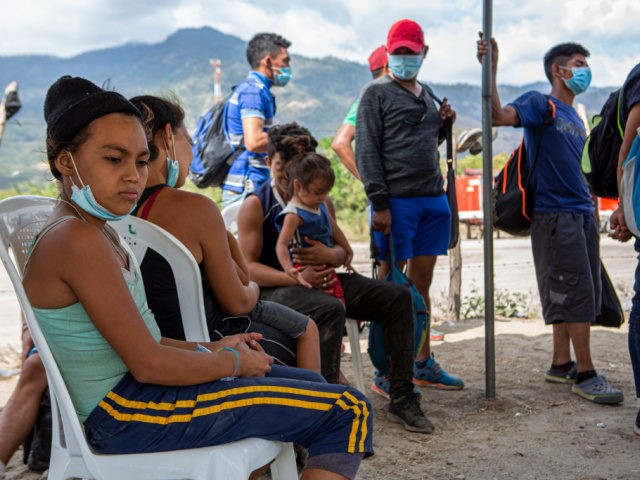The Biden team’s permissive migration enforcement policy is causing economic chaos among poverty-stricken Central Americans who took unsustainable debt to try to sneak into the U.S. but failed.
Now, these deported migrants, many of whom used their house as collateral, are indebted and scared that their unsuccessful migration could cost them more than they can bear.
Lax border policies under President Joe Biden are attracting more migrants, prompting them to take out loans that fill the coffers of smugglers, who often work for drug cartels and rape women and girls during the journey. If the migrants fail to make it into the U.S., they will find themselves deeper in the red.
The Biden administration maintained the Trump-era pandemic control protocols (Title 42) that allow the government to deport any migrant quickly. Still, it loosened the measure, granting an exception to unaccompanied children while agents are supposed to deport all other illegal migrants.
Not all Central Americans are eligible for a Title 42 exemption, even while Biden allows some families and single adults, many from outside the Americas, into the country while claiming the border is closed. U.S. Border Patrol blames Mexico’s reluctance to allow them to deport some non-Mexican families and single adults into their territory, not Biden’s policy, for exempting some migrants from Title 42 removal.
Still, the Biden administration ended the Trump-era policy of flying deported Central Americans to their home countries.
Under Biden, the U.S. Department of Homeland Security (DHS) is merely expelling apprehended Central Americans back the five-yard line in Mexico, rather than their home countries thousands of miles away, leaving them to try again after a short rest. Traditional penalties for repeat border crossers such as jail time do not apply to Title 42 removals.
NBC News aptly reported this week;
In reality, the border is not closed. Under Biden, the determination of who stays and who goes has become a lottery with winners and losers. Timing is everything, the merits of an asylum claim often beside the point. On some days here in the Rio Grande Valley, the busiest section of the U.S.-Mexico border, families … expelled, while on others, single males who’ve come looking for work are allowed to stay pending their hearings.
Despite their ability to keep crossing the border time and time again, Central American migrants who do not make it in still have to come up with thousands of dollars to pay smugglers.
Human traffickers have changed their tactics in response to Biden’s migration policies.
They now charge a flat fee of about $13,000 for as many attempts as possible in three months, Reuters learned from an anonymous 35-year-old Guatemalan migrant who made it into the U.S. on his seventh try.
Those who do not make it can pay an additional $2,600 for another three-month round.
Some migrants welcome Biden’s version of Title 42.
“That’s the wonderful thing now,” Lucio Portillo, a 44-year-old Honduran migrant, told the Wall Street Journal on March 24.
“You have the opportunity to bat again and again — that’s better for us,” he added.
The Guatemalan migrant who made it after six tries “was facing the prospect of failure and going back home to thousands of dollars of debt” if he failed, Reuters noted.
“Smugglers in recent years have promised would-be migrants [at least] three tries at successfully crossing the U.S. border — an acknowledgment that it’s a large investment that doesn’t always pan out,” the Associated Press (AP) reported Friday, describing a different tactic from the one mentioned by Reuters.
AP highlighted a story of a different Guatemalan migrant, 42-year-old Alvina Jerónimo Pérez, who is now facing the prospect of losing her home after using it as collateral to pay $7,700 for a failed attempt to sneak into the U.S.
Although she attempted to enter the U.S. illegally last year, Jerónimo’s plight, along with that of others who have also tried to get to America this year, highlights how the migrant surge is currently wreaking economic havoc in Central America.
AP conceded:
Jerónimo’s story is similar to that of thousands of Guatemalans who scramble to gather the money needed to migrate to the United States. Often it comes from relatives already living in the U.S. or networks of informal lenders. Sometimes migrants must sell their possessions, including their homes, or like Jerónimo, use the deeds as collateral. They are driven by the chance of breaking the cycle of poverty that affects 60% of the country’s.
Drowning in debt makes Jerónimo scared even to leave her house, “She, like many others, sees no way out but to try again.”
The surge began during the last days of the Trump administration when then-presidential candidates Biden and Kamala Harris were sending welcoming messages to would-be migrants. Once Biden took office, the surge evolved into an unfolding humanitarian crisis.

COMMENTS
Please let us know if you're having issues with commenting.